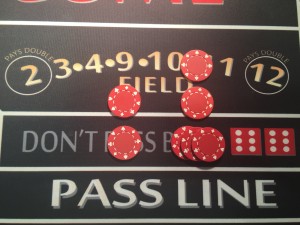Lesson Four
Playing The Don’t Pass – The Dice Don’t Pass
~Click on images to enlarge~
Often a misunderstood bet, the Don’t Pass bet is not playing with the “house”. Playing the Don’t Pass is just another way of betting. It is a different approach for playing the game. Put on your thinking cap. Playing the Don’t Pass is the opposite of playing the Pass Line. When playing the Don’t Pass, you are betting that the dice won’t pass, hence, Don’t Pass. You are betting that the result of the hand will be a loser for the Pass Line bettor. The house advantage is about the same as the Pass Line, 1.36%.
Making a Don’t Pass Bet
For the Don’t Pass bettor, 7 or 11 on the Come Out is a losing roll. Two or three is a natural winner. Twelve is barred or a push. After a point is established, the Don’t Pass bet wins when a 7 rolls before the point, (4-5-6-8-9-10). In this way, the casino is able to have a favorable advantage over the Don’t Pass bet as well as the Pass Line bet. So, either way you play, the casino has the advantage. Who would have guessed?
We already know that a Don’t Pass bet is made during a Come Out roll. The Don’t Pass Line bet is not a contract bet. You may pick-up the bet anytime you want. Of course, once the bet is behind a point, the player has an advantage, as the odds favor the Don’t Pass bet to win. Once a Don’t Pass bet has cleared the seven or eleven, on a Come Out, it is behind a point. Now, the bet is the odds on favorite to win. Understanding this important fact, you would never want to remove a Don’t Pass bet once it is behind a point.
The Don’t Pass bet is paid even money when it wins. It wins when either a 2 or 3 rolls on a Come Out, or when a 7 rolls after the Don’t Pass bet is behind the established point. The bet loses to a 7 or 11, on a Come Out, or after the shooter repeats the point, (4-5-6-8-9-10).
Laying the Odds – That Seems Odd
Let’s move on to laying odds with a Don’t Pass bet. Similar to a Pass Line bet, an Odds Bet may be made with a Don’t Pass bet. Do you still have the thinking cap on? When the dice are not passing, not winning for the Pass Line player, playing the Don’t Pass could make good “cents”. Just like a Pass Line bet, the player can make an additional odds bet, along with the Don’t Pass bet. Instead of taking the odds as with a Pass Line bet, you will be Laying the Odds with the Don’t Pass bet.
The tricky part, when betting the Don’t Pass, has to do with the payout. Since a Don’t Pass bet is favored with six ways to win, six combinations for a seven, the odds bet is a “lay bet”. More money must be laid to win less. Yes, that does seem odd. However, it is correct because remember, the bet, is favored to win. This is figured by the true odds determining the payout. Once the Don’t Pass bet is favored to win, the Odds Bet is also favored to win. There is no house advantage other than on the original Don’t Pass bet, which is paid flat. Here is the explanation for the odds. When playing the Don’t Pass and behind a point, the bet is favored to win by 2:1 over the 4 or 10, 3:2 over the 5 or 9 and 6:5 over the 6 or 8.
Let’s look at a point of nine with a Don’t Pass bet of $5. You must lay bet $15 with a $5 Don’t Pass bet when the point is nine. You will lay three units in Odds bet to win two units. Get it? (3:2) It is exactly the opposite payout of the Pass Line’s Odds bet. Take a minute here to digest what you just read.
A Pass Line bet of $5 with $10 double odds and a point of nine, wins a total of $20.
The Pass Line is paid even money at $5 and the Odds bet is paid 3:2 at $15 to $10, for a total payout of $20. You have $15 in action to win $20.
Whereas, the Don’t Pass bet has $20 in action to win $15. ($5 Don’t Pass bet and a $15 lay bet in odds) The Don’t Pass bet is paid even money, $5 and the Odds bet (3 units) is paid 2 units, $10. The total payout is $15. The risk is $20 in action.
Now, compare the two bets, Pass Line and Don’t Pass. Compare the total units bet for each Odds Bet. Next, compare the payout for each and you will see the answer to why, “that seems odd!”
So, how does the casino stay in business? Let’s let them worry about that. They seem to be doing okay.
| 4 | 5 | 6 | 8 | 9 | 10 |
| 2 to 1 | 3 to 2 | 6 to 5 | 6 to 5 | 3 to 2 | 2 to 1 |
| Lay 2 units to win 1 unit. | Lay 3 units to win 2 units. | Lay 6 units to win 5 units. | Lay 6 units to win 5 units. | Lay 3 units to win 2 units. | Lay 2 units to win 1 unit. |
The Example below shows a Don’t Pass bet payoff on a Five or Nine
The amount you may lay in odds varies from casino to casino. It is recommended, until you have a command of the game, that you stick with double odds in the beginning. You will have to learn the odds so you can lay the correct Odds Bet for each of the box numbers. The house advantage on a Don’t Pass bet with double odds is about .45%.
If you are having difficulty figuring out the odds, go back and review Lesson Three for the Pass Line. The payouts for the Don’t Pass Odds Bet are opposite to the Pass Line Odds bet. Notice that the payout for a Pass Line Odds Bet is the same amount you must lay for a Don’t Pass Odds bet.
Let’s Do a Quick Review
When the Don’t Pass bet wins with an Odds Bet, you are paid even money for the Don’t Pass bet and true odds for the Odds bet. The true odds paid is determined by the point’s number. Odds are expressed by the number of ways a point has of winning versus the number of ways of losing to the seven.
Look at the 4 and 10 for example. Refer back to the table above if you need to. (see True Odds table) The 4 or 10 have three possible combinations of rolling compared to six ways for a seven.
The 4 has 1/3, 3/1, and 2//2
The 10 has 4/6, 6/4, and 5/5
Those are the three ways of rolling 4 or 10
The 7 has six combinations of rolling 1/6, 6/1, 2/5, 5/2, 3/4, 4/3
So, as a Don’t Pass bettor, with the 4 or 10 as a point, we have 3 ways to lose versus six ways to win. Thus, the True Odds for the 4 or 10 are 6:3 or simplified as 2:1. Simplified, there are two ways to win and one way to lose. Understanding this, you have to lay two units to win one unit, according to the True Odds.
A $5 Don’t Pass bet with an Odds Bet of $20, is paid a total of $15. $5 is paid for the Don’t Pass bet at even money and $10 is paid for every two units ($20) bet in odds. You have two times in lay action to win one unit of profit for an Odds Bet payout of $10.
The Odds Bet is paid True Odds for each of the box numbers, (4-5-6-8-9-10). See the True Odds table for more detail.
Some casinos offer raiser odds, and/or multiple odds, greater than raiser odds. Again, when you are just learning, double odds will be plenty for you to play, win or lose.
There are six sides to a die and with two dice; there are thirty-six combinations possible. Below is a table of the thirty-six possibilities for rolling the eleven numbers.
| Number | Dice Combinations | Possibilities |
| 2 | 1-1 | 1 |
| 3 | 1-2, 2-1 | 2 |
| 4 | 1-3, 3-1, 2-2 | 3 |
| 5 | 1-4, 4-1, 2-3, 3-2 | 4 |
| 6 | 1-5, 5-1, 2-4, 4-2, 3-3 | 5 |
| 7 | 1-6, 6-1, 2-5, 5-2, 3-4, 4-3 | 6 |
| 8 | 2-6, 6-2, 3-5, 5-3, 4-4 | 5 |
| 9 | 3-6, 6-3, 4-5, 5-4, | 4 |
| 10 | 1-3, 3-1, 2-2 | 3 |
| 11 | 5-6, 6-5 | 2 |
| 12 | 6-6 | 1 |
The probability is expressed as a ratio of the number of ways of rolling a certain number, divided by the total possible combinations. Examples: There is one possible combination of rolling 12, 6/6. Thus, the odds of a 12 rolling is one in thirty-six or 1/36. There are six possible combinations for rolling a 7. Thus the probability of a 7 rolling is 6/36 or 1/6. Once in every six rolls.
True odds are expressed by the number of possible winning combinations versus the number of losing combinations. Example: For the 6 or 8 the true odds are 6 to 5. Six ways for a Don’t bet to win and five ways of losing to either a six or eight. Thus, the odds for a Don’t bet are 6:5.
In Conclusion for Playing the Don’t Pass Line
The Don’t Pass bet is an opposite play to the Pass Line bet. The bet is made against the dice, that is, the dice will not Pass and the 7 will roll before the point. The odds portion of the bet are paid True Odds and reduces the house advantage over the Don’t Pass bet with double odds to about .45%.
In lesson 5, you will learn how to make a Come bet. Until then, when playing the Don’t Pass, may all your Come Outs be Craps, 2 or 3!
Return to the Table of Contents
Copyright © 2006-2015 Michael Vernon – Playing 4 Keeps®





